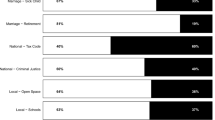Abstract
The present study tested the power of equity measures to predict students' commitment to college. Different patterns of results were observed across three academic disciplines (physics, economics, and political science), which are characterized by different levels of environmental uncertainty. Equity was found to be a more relevant predictor of students' behavior and attitudes in fields with a high level of paradigm development. In political science, the major predictor of students' commitment was the comparison of one's group with another. The dominant independent variable in economics was the comparison within the membership group, while in physics the main predictor was the internal standard. The policy implications of these findings are discussed.
Similar content being viewed by others
References
Adams, J. S. Inequity in social exchange. In L. Berkowitz (Ed.),Advances in Experimental Social Psychology (Vol. 2). New York: Academic Press, 1965, pp. 267–299.
Blau, P. M.Exchange and Power in Social Life. New York: Wiley, 1964.
Buchanan, B. Building organizational commitment: the socialization of managers in work organization.Administrative Science Quarterly 1974,19 533–546.
Cook, J., and Wall, T. New York attitude measures of trust, organizational commitment and personal need non-fulfillment.Journal of Occupational Psychology 1980,53 39–52.
Grusky, O. Career mobility and organization commitment.Administrative Science Quarterly 1966,10 488–503.
Hrebiniak, L. G. Effects of job level and participation on employee attitudes and perceptions of influence.Academy of Management Journal 1974,17 649–662.
Kuhn, T.The Structure of Scientific Revolutions. (2nd ed.). Chicago: University of Chicago Press, 1970.
Lawrence, P. R., and Lorsch, J. W.Organization and Environment. Cambridge, Mass.: Harvard University, Graduate School of Business Administration, Division of Research, 1967.
Lodahl, J. B., and Gordon, G. The structure of scientific fields and the functioning of university graduate departments.American Sociological Review 1972,37 57–72.
Mowday, R. T., Steers, R. M., and Porter, L. W. The measurement of organizational commitment.Journal of Vocational Behavior 1979,14 224–247.
Neumann, Y. Predicting faculty success in university graduate departments.Research in Higher Education 1977,6 275–287. (a)
Neumann, Y. Standards of research publications: differences between the physical sciences and the social sciences.Research in Higher Education 1977,7 355–367. (b)
Neumann, Y. Predicting faculty job satisfaction in university departments.Research in Higher Education 1978,9 261–275.
Neumann, Y. The perception of change in university departments.Research in Higher Education 1979,11 45–58.
Neumann, Y. A contingency approach for unverstanding equity theory and its predictions.Social Behavior and Personality 1980,8 153–159.
Patchen, M.Participation, Achievement, and Involvement on the Job. Englewood Cliffs, N.J.: Prentice-Hall, 1970.
Pfeffer, J., Leong, A., and Strehl A.. Publication and prestige mobility of university departments in three scientific disciplines.Sociology of Education 1976,49 212–218.
Porter, L. W., Steers, R. M., Mowsay, R. T. and Boulian, P. V. Organizational commitment, job satisfaction, and turnover among psychiatric technicians.Journal of Applied Psychology 1974,59 603–609.
Runcimann, W. G.Relative Deprivation and Social Justice. Berkeley, Calif.: University of California Press, 1966.
Schein, E.Organizational Psychology. Englewood Cliffs, N.J.: Prentice-Hall, 1970.
Steers, R. M. Problems in the measurement of organizational effectiveness.Administrative Science Quarterly 1975,20 546–558.
Steers, R. M.Organizational Effectiveness: A Behavioral View. Santa Monica, Calif.: Goodyear, 1977.
Thibaut, J. M., and Kelley, H. H.The Social Psychology of Groups. New York: Wiley, 1959.
Weick, K. E. The concept of equity in the perception of pay.Administrative Science Quarterly 1966,11 414–434.
Yoels, W. C. The structure of scientific fields and the allocation of editorship on scientific journals.Sociological Quarterly 1974,15 264–276.
Author information
Authors and Affiliations
Rights and permissions
About this article
Cite this article
Neumann, Y., Neumann, L. Equity theory and students' commitment to their college. Res High Educ 20, 269–280 (1984). https://doi.org/10.1007/BF00983502
Received:
Issue Date:
DOI: https://doi.org/10.1007/BF00983502




